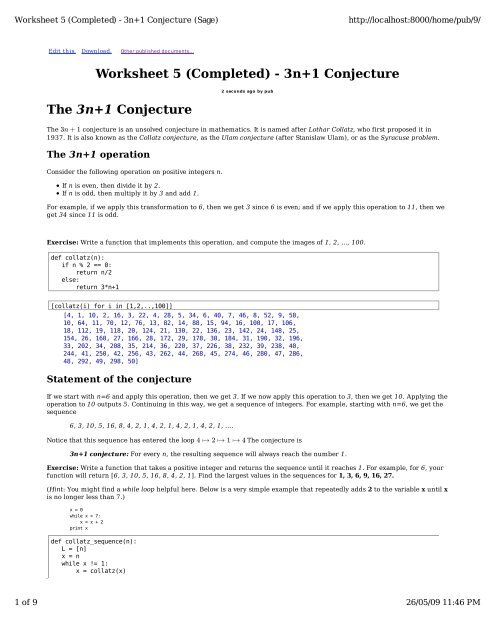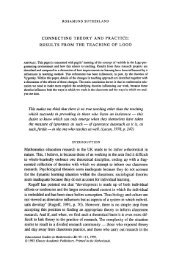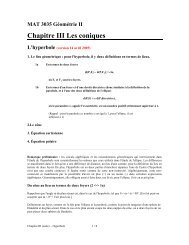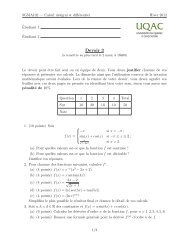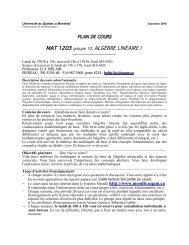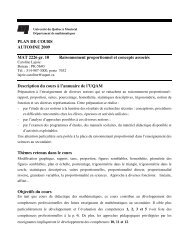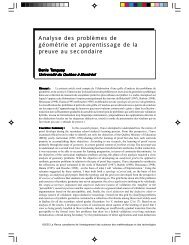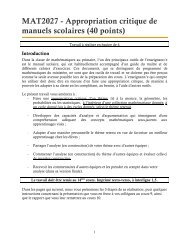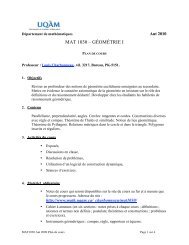Worksheet 5 (Completed) - 3n+1 Conjecture
Worksheet 5 (Completed) - 3n+1 Conjecture
Worksheet 5 (Completed) - 3n+1 Conjecture
Create successful ePaper yourself
Turn your PDF publications into a flip-book with our unique Google optimized e-Paper software.
<strong>Worksheet</strong> 5 (<strong>Completed</strong>) - <strong>3n+1</strong> <strong>Conjecture</strong> (Sage)<br />
http://localhost:8000/home/pub/9/<br />
Edit this. Download.<br />
Other published documents...<br />
<strong>Worksheet</strong> 5 (<strong>Completed</strong>) - <strong>3n+1</strong> <strong>Conjecture</strong><br />
The <strong>3n+1</strong> <strong>Conjecture</strong><br />
2 seconds ago by pub<br />
The 3n + 1 conjecture is an unsolved conjecture in mathematics. It is named after Lothar Collatz, who first proposed it in<br />
1937. It is also known as the Collatz conjecture, as the Ulam conjecture (after Stanislaw Ulam), or as the Syracuse problem.<br />
The <strong>3n+1</strong> operation<br />
Consider the following operation on positive integers n.<br />
If n is even, then divide it by 2.<br />
If n is odd, then multiply it by 3 and add 1.<br />
For example, if we apply this transformation to 6, then we get 3 since 6 is even; and if we apply this operation to 11, then we<br />
get 34 since 11 is odd.<br />
Exercise: Write a function that implements this operation, and compute the images of 1, 2, ..., 100.<br />
def collatz(n):<br />
if n % 2 == 0:<br />
return n/2<br />
else:<br />
return 3*n+1<br />
[collatz(i) for i in [1,2,..,100]]<br />
[4, 1, 10, 2, 16, 3, 22, 4, 28, 5, 34, 6, 40, 7, 46, 8, 52, 9, 58,<br />
10, 64, 11, 70, 12, 76, 13, 82, 14, 88, 15, 94, 16, 100, 17, 106,<br />
18, 112, 19, 118, 20, 124, 21, 130, 22, 136, 23, 142, 24, 148, 25,<br />
154, 26, 160, 27, 166, 28, 172, 29, 178, 30, 184, 31, 190, 32, 196,<br />
33, 202, 34, 208, 35, 214, 36, 220, 37, 226, 38, 232, 39, 238, 40,<br />
244, 41, 250, 42, 256, 43, 262, 44, 268, 45, 274, 46, 280, 47, 286,<br />
48, 292, 49, 298, 50]<br />
Statement of the conjecture<br />
If we start with n=6 and apply this operation, then we get 3. If we now apply this operation to 3, then we get 10. Applying the<br />
operation to 10 outputs 5. Continuing in this way, we get a sequence of integers. For example, starting with n=6, we get the<br />
sequence<br />
6, 3, 10, 5, 16, 8, 4, 2, 1, 4, 2, 1, 4, 2, 1, 4, 2, 1, ....<br />
Notice that this sequence has entered the loop 4 7! 2 7! 1 7! 4. The conjecture is<br />
<strong>3n+1</strong> conjecture: For every n, the resulting sequence will always reach the number 1.<br />
Exercise: Write a function that takes a positive integer and returns the sequence until it reaches 1. For example, for 6, your<br />
function will return [6, 3, 10, 5, 16, 8, 4, 2, 1]. Find the largest values in the sequences for 1, 3, 6, 9, 16, 27.<br />
(Hint: You might find a while loop helpful here. Below is a very simple example that repeatedly adds 2 to the variable x until x<br />
is no longer less than 7.)<br />
x = 0<br />
while x < 7:<br />
x = x + 2<br />
print x<br />
def collatz_sequence(n):<br />
L = [n]<br />
x = n<br />
while x != 1:<br />
x = collatz(x)<br />
1 of 9 26/05/09 11:46 PM
<strong>Worksheet</strong> 5 (<strong>Completed</strong>) - <strong>3n+1</strong> <strong>Conjecture</strong> (Sage)<br />
http://localhost:8000/home/pub/9/<br />
L.append(x)<br />
return L<br />
collatz_sequence(11)<br />
[11, 34, 17, 52, 26, 13, 40, 20, 10, 5, 16, 8, 4, 2, 1]<br />
for i in [1,3,6,9,16,27]:<br />
print i, max(collatz_sequence(i))<br />
1 1<br />
3 16<br />
6 16<br />
9 52<br />
16 16<br />
27 9232<br />
Exercise: Use the line command to plot the sequence for 27.<br />
line([(i, x) for (i,x) in enumerate(collatz_sequence(27))])<br />
Exercise: Write an @interact function that takes an integer n and plots the sequence for n.<br />
@interact<br />
def f(n=27):<br />
line([(i, x) for (i,x) in enumerate(collatz_sequence(n))]).show()<br />
Stopping Time<br />
The number of steps it takes for a sequence to reach 1 is the stopping time. For example, the stopping time of 1 is 0 and the<br />
stopping time of 6 is 8.<br />
Exercise: Write a function that returns the stopping time of a poisitve integer n. Plot the stopping times for 1, 2, ..., 100 in a<br />
bar chart.<br />
def stopping_time(n):<br />
st = 0<br />
x = n<br />
while x != 1:<br />
st += 1<br />
2 of 9 26/05/09 11:46 PM
<strong>Worksheet</strong> 5 (<strong>Completed</strong>) - <strong>3n+1</strong> <strong>Conjecture</strong> (Sage)<br />
http://localhost:8000/home/pub/9/<br />
x = collatz(x)<br />
return st<br />
bar_chart([stopping_time(i) for i in range(1,1001)])<br />
Exercise: Find the number less than 1000 with the largest stopping time. What is its stopping time? Repeat this for 2000,<br />
3000, ..., 10000.<br />
[max([(stopping_time(i), i) for i in range(1,m+1)]) for m in [1000, 2000, .., 10000]]<br />
[(178, 871), (181, 1161), (216, 2919), (237, 3711), (237, 3711),<br />
(237, 3711), (261, 6171), (261, 6171), (261, 6171), (261, 6171)]<br />
Extension to Complex Numbers<br />
Exercise: If n is odd, then 3n + 1 is even. So we can instead consider the operation that maps n to 2, if n is even; and to 2 ,<br />
if n is odd.<br />
f (z) = z 2 cos2 (z )<br />
(3z+1) sin 2 Ù<br />
(z ).<br />
Construct f as a symbolic function and use Sage to show that f(n) = T (n) for all 1 Ô n Ô 1000<br />
, where T is the 2 -operator.<br />
Afterwards, argue that f is a smooth extension of T to the complex plane (you have to argue that applying f to a positive<br />
integer has the same effect as applying T to that integer. You don't need Sage to do this, but it might offer you some insight!)<br />
f(z) = z/2 * cos(z*pi/2)^2 + (3*z+1)/2 * sin(z*pi/2)^2<br />
f(z)<br />
(3*z + 1)*sin(pi*z/2)^2/2 + z*cos(pi*z/2)^2/2<br />
T = lambda n : n/2 if n % 2 == 0 else (3*n+1)/2<br />
all(f(i) == T(i) for i in range(1000))<br />
True<br />
Ù 2<br />
+ 2<br />
2<br />
n<br />
<strong>3n+1</strong><br />
<strong>3n+1</strong><br />
Exercise: Let g(z) be the complex function:<br />
1<br />
g(z) = 4<br />
(1 + 4z À ( 1 + 2z) cos(Ùz))<br />
.<br />
Construct g as a symbolic function, and show that f and g are equal.<br />
Note: You can do this using a combination of Sage and Maxima. Sage wraps some of Maxima's functions, but not all. For<br />
example, in Sage you can write f.trig_expand(). If you want to use some of Maxima's commands, then you can do the<br />
following:<br />
3 of 9 26/05/09 11:46 PM
<strong>Worksheet</strong> 5 (<strong>Completed</strong>) - <strong>3n+1</strong> <strong>Conjecture</strong> (Sage)<br />
http://localhost:8000/home/pub/9/<br />
maxima(f).trigexpand().sage()<br />
This command converts f into a Maxima object (via the command maxima(f)), then applies the Maxima function<br />
trigexpand, and then converts the result into a Sage object (via the method .sage()). To see the available Maxima<br />
commands, you can type: maxima..<br />
g(z) = 1/4 * (1 + 4*z - (1+2*z) * cos(pi*z))<br />
g(z)<br />
((-2*z - 1)*cos(pi*z) + 4*z + 1)/4<br />
maxima(f.trig_simplify()).trigreduce().sage() - g(z)<br />
0<br />
Exercise: Use the command_plot command to plot g in the domain x = À 5; :::;<br />
5and y = À 5; :::;<br />
5.<br />
complex_plot(g, (-5,5), (-5,5))<br />
Exercise: Consider the composition h n (z) = ( g Î g Î Á Á Á Î g)<br />
(where there are n copies of g in this composition). Use<br />
complex_plot and graphics_array to plot h 1, h 2, h 3, ..., h 6 on the domain x = 1 ; :::; 5 and y = À 0:5; :::; 0:5<br />
.<br />
(Hint: To speed things up or control the percision of the computations, you may want to replace pi in your equation with<br />
CDF.pi(). Type CDF? and CDF.pi? for more information.)<br />
def h(n):<br />
C = CDF<br />
def h_n(z):<br />
z = C(z)<br />
for _ in range(n):<br />
z = 1/4 * (1 + 4*z - (1+2*z) * cos(C.pi()*z))<br />
return z<br />
return h_n<br />
plots = []<br />
for n in range(1,7):<br />
print n<br />
P = complex_plot(h(n), (1,5), (-0.5,0.5), plot_points=500)<br />
P.axes(False)<br />
plots.append(P)<br />
4 of 9 26/05/09 11:46 PM
<strong>Worksheet</strong> 5 (<strong>Completed</strong>) - <strong>3n+1</strong> <strong>Conjecture</strong> (Sage)<br />
http://localhost:8000/home/pub/9/<br />
1<br />
2<br />
3<br />
4<br />
5<br />
6<br />
graphics_array(plots, 6, 1).show(figsize=(10,10))<br />
Exercise: Generate some really nice images of h n that illustrate the fractal-like behaviour of h n. (Hint: You may want to<br />
explore the plot_points and interpolation options for the complex_plot command.)<br />
complex_plot(h(6), (1, 5), (-0.75,0.75), plot_points=250)<br />
5 of 9 26/05/09 11:46 PM
<strong>Worksheet</strong> 5 (<strong>Completed</strong>) - <strong>3n+1</strong> <strong>Conjecture</strong> (Sage)<br />
http://localhost:8000/home/pub/9/<br />
complex_plot(h(6), (3.5, 4.5), (-0.5,0.5), plot_points=250)<br />
complex_plot(h(6), (3.50, 3.75), (-0.1,0.1), plot_points=250)<br />
complex_plot(h(6), (3.53, 3.57), (-0.03,0.03), plot_points=250)<br />
6 of 9 26/05/09 11:46 PM
<strong>Worksheet</strong> 5 (<strong>Completed</strong>) - <strong>3n+1</strong> <strong>Conjecture</strong> (Sage)<br />
http://localhost:8000/home/pub/9/<br />
complex_plot(h(9), (3.53, 3.57), (-0.03,0.03), plot_points=400)<br />
complex_plot(h(9), (3.534, 3.540), (-0.005,0.005), plot_points=250)<br />
complex_plot(h(6), (1, 5), (-0.75,0.75), plot_points=250)<br />
7 of 9 26/05/09 11:46 PM
<strong>Worksheet</strong> 5 (<strong>Completed</strong>) - <strong>3n+1</strong> <strong>Conjecture</strong> (Sage)<br />
http://localhost:8000/home/pub/9/<br />
complex_plot(h(6), (3.5, 4.5), (-0.75,0.75), plot_points=250)<br />
complex_plot(h(6), (3.75, 4), (0,0.25), plot_points=250)<br />
complex_plot(h(9), (3.75, 4), (0,0.25), plot_points=250)<br />
8 of 9 26/05/09 11:46 PM
<strong>Worksheet</strong> 5 (<strong>Completed</strong>) - <strong>3n+1</strong> <strong>Conjecture</strong> (Sage)<br />
http://localhost:8000/home/pub/9/<br />
time complex_plot(h(15), (3.85, 3.90), (0.05,0.075), plot_points=500)<br />
9 of 9 26/05/09 11:46 PM


